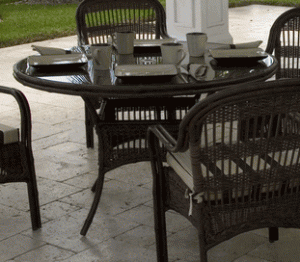





The uses to which areas of the garden are put are directly proportional to their convenience and attractiveness. Each part for living in, whether it is a convenient corner by the back door or a carefully designed terrace, needs furniture just as much as any room indoors. The choice is hardly less wide but an initial divide occurs between furniture which stays out all or most of the time and that which has to be expressly put out for use.
Even a small garden needs a seat or two, or a bench in the warmest corner, which is always there for immediate use, for example for a morning cup of coffee or to string the beans for lunch. Few people, however, would feel justified in making time to take a chair out for so short a time. Convenience is all. Again, if there is one spot which gets late sun, or midday shade or enjoys a particularly beautiful view, this is where a permanent seat should be.
 Often, because of its position, the seat is itself a garden feature, an eye-catcher at the end of a path or in another prominent position. This is a spot to concentrate planting which complements the time of day when the seat is most in use: morning glory and cistuses for forenoon use, night-scented stocks, tobacco plants, evening primroses and Cestrum parqui for a late-day post-work place.
Often, because of its position, the seat is itself a garden feature, an eye-catcher at the end of a path or in another prominent position. This is a spot to concentrate planting which complements the time of day when the seat is most in use: morning glory and cistuses for forenoon use, night-scented stocks, tobacco plants, evening primroses and Cestrum parqui for a late-day post-work place.
Materials of permanent seats must be durable. Cast iron or its modern alternative, aluminium alloy, and stone have complete permanence while the most weather-resistant woods, teak and western red cedar, benefit from being taken under cover in winter — although they do not demand it.
Houses and gardens with a period flavour gain from having furniture to fit that period: reeded iron Regency seats or florid floral Victorian ones add to the feeling. Fortunately any number of good reproductions are now available.
Stone seats naturally weather, though they may take some years to attain that patina we envy when visiting great gardens. Do remember to keep a cushion or two to hand: stone can be very chilly to sit on.
Choice in wooden furniture is wide. Usually the simpler the design the better, and of good solid construction: cheapness seldom equates with economy. Seldom, too, are rustic confections at all satisfactory from the points of view of either comfort or aesthetics.
As a table, a big flagstone, a marble wash-stand top or a piece of slate can all be brought into use with any number of possible permanent supports.
In many cases we need movable garden furniture to take advantage of changing sun and shade. Here the range is even greater and the choice more confusing. In general it should be light to handle and easy to store (where will that great swing-seat go in the winter?) Collapsible designs are frequently the answer but they must be easy to erect. Avoid, too, any type of garden seat or table with thin, spindly legs: the table will tilt alarmingly as it inevitably finds the cracks between paving stones on the terrace and the chairs sink inexorably beneath you into the lawn.
Copyright © www.100flowers.win Botanic Garden All Rights Reserved